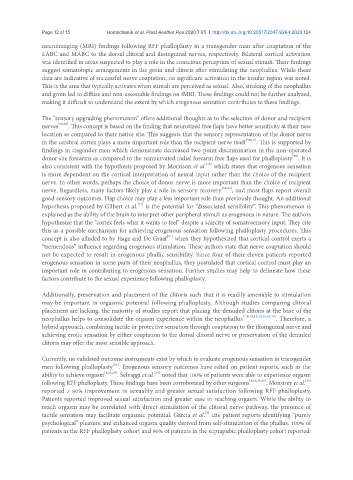Page 775 - Read Online
P. 775
Page 12 of 15 Hontscharuk et al. Plast Aesthet Res 2020;7:65 I http://dx.doi.org/10.20517/2347-9264.2020.124
neuroimaging (MRI) findings following RFF phalloplasty in a transgender man after coaptation of the
LABC and MABC to the dorsal clitoral and ilioinguinal nerves, respectively. Bilateral cortical activation
was identified in areas suspected to play a role in the conscious perception of sexual stimuli. Their findings
suggest somatotopic arrangements in the groin and clitoris after stimulating the neophallus. While these
data are indicative of successful nerve coaptation, no significant activation in the insular region was noted.
This is the area that typically activates when stimuli are perceived as sexual. Also, stroking of the neophallus
and groin led to diffuse and non-assessable findings on fMRI. These findings could not be further analyzed,
making it difficult to understand the extent by which erogenous sensation contributes to these findings.
The “sensory upgrading phenomenon” offers additional thoughts as to the selection of donor and recipient
nerves [58,69] . This concept is based on the finding that neurotized free flaps have better sensitivity at their new
location as compared to their native site. This suggests that the sensory representation of the donor nerve
in the cerebral cortex plays a more important role than the recipient nerve itself [58,69] . This is supported by
findings in cisgender men which demonstrate decreased two-point discrimination in the non-operated
[58]
donor site forearms as compared to the reinnervated radial forearm free flaps used for phalloplasty . It is
[15]
also consistent with the hypothesis proposed by Morrison et al. which states that erogenous sensation
is more dependent on the cortical interpretation of neural input rather than the choice of the recipient
nerve. In other words, perhaps the choice of donor nerve is more important than the choice of recipient
nerve. Regardless, many factors likely play a role in sensory recovery [58,69] , and most flaps report overall
good sensory outcomes. Flap choice may play a less important role than previously thought. An additional
[71]
hypothesis proposed by Gilbert et al. is the potential for “dissociated sensibility”. This phenomenon is
explained as the ability of the brain to interpret other peripheral stimuli as erogenous in nature. The authors
hypothesize that the “cortex feels what it wants to feel” despite a scarcity of somatosensory input. They cite
this as a possible mechanism for achieving erogenous sensation following phalloplasty procedures. This
[31]
concept is also alluded to by Hage and De Graaf when they hypothesized that cortical control exerts a
“tremendous” influence regarding erogenous stimulation. These authors state that nerve coaptation should
not be expected to result in erogenous phallic sensibility. Since four of their eleven patients reported
erogenous sensation in some parts of their neophallus, they postulated that cortical control must play an
important role in contributing to erogenous sensation. Further studies may help to delineate how these
factors contribute to the sexual experience following phalloplasty.
Additionally, preservation and placement of the clitoris such that it is readily amenable to stimulation
may be important in orgasmic potential following phalloplasty. Although studies comparing clitoral
placement are lacking, the majority of studies report that placing the denuded clitoris at the base of the
neophallus helps to consolidate the orgasm experience within the neophallus [7,8,10,15,28,29,42,70] . Therefore, a
hybrid approach, combining tactile or protective sensation through coaptation to the ilioinguinal nerve and
achieving erotic sensation by either coaptation to the dorsal clitoral nerve or preservation of the denuded
clitoris may offer the most sensible approach.
Currently, no validated outcome instruments exist by which to evaluate erogenous sensation in transgender
[15]
men following phalloplasty . Erogenous sensory outcomes have relied on patient reports, such as the
[29]
ability to achieve orgasm [8,22,29] . Selvaggi et al. noted that 100% of patients were able to experience orgasm
[24]
following RFF phalloplasty. These findings have been corroborated by other surgeons [8,15,22,24] . Monstrey et al.
reported > 80% improvement in sexuality and greater sexual satisfaction following RFF phalloplasty.
Patients reported improved sexual satisfaction and greater ease in reaching orgasm. While the ability to
reach orgasm may be correlated with direct stimulation of the clitoral nerve pathway, the presence of
[8]
tactile sensation may facilitate orgasmic potential. Garcia et al. cite patient reports identifying “purely
psychological” pleasure and enhanced orgasm quality derived from self-stimulation of the phallus. 100% of
patients in the RFF phalloplasty cohort and 90% of patients in the suprapubic phalloplasty cohort reported:

